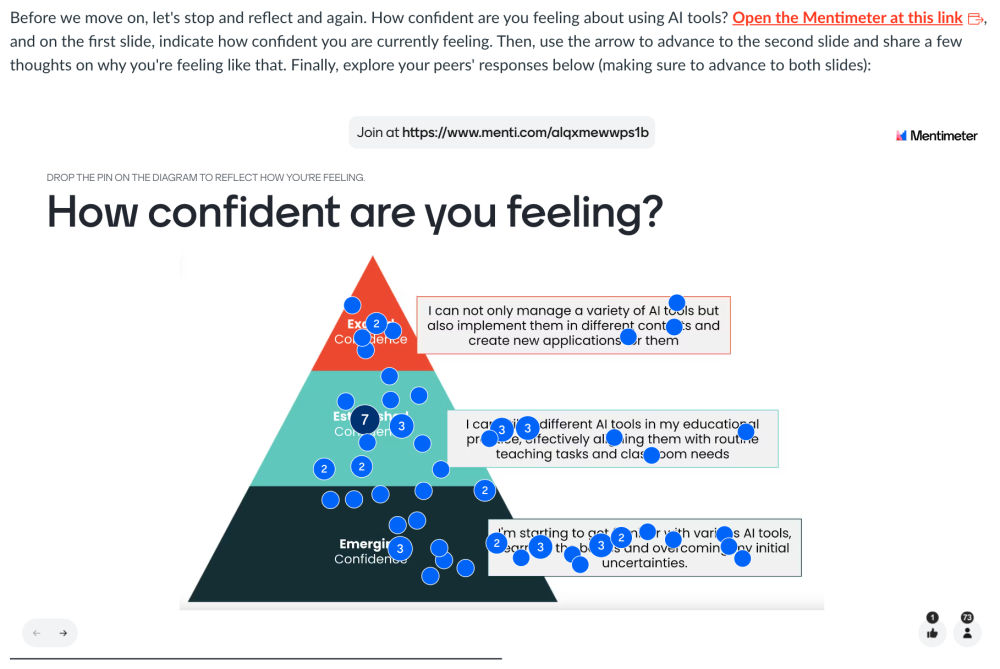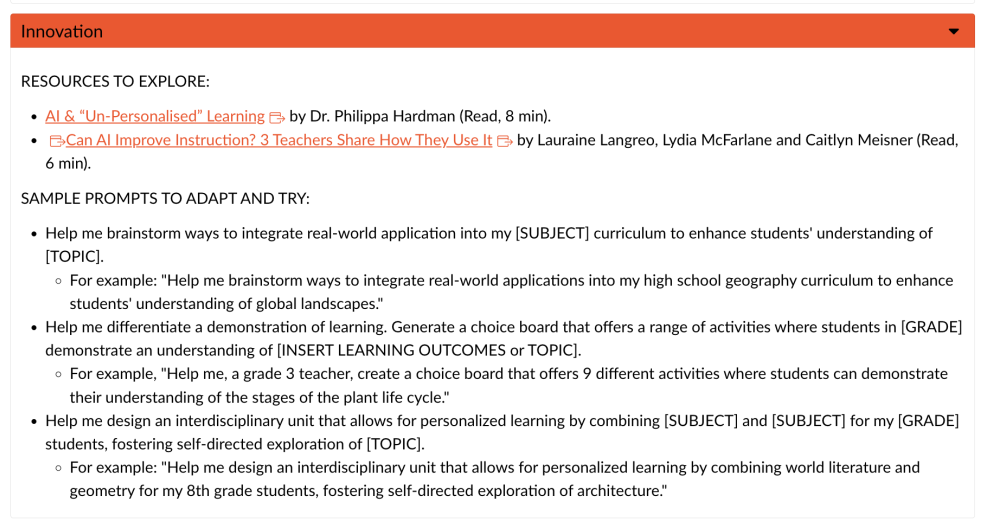Designing for Educators as Learners: Belonging, Flexibility and Relevance
In the realm of education, we often focus on creating optimal learning environments for students. However, we sometimes overlook one crucial element: the learning experiences of educators themselves. Just as we carefully craft lessons for our students, we must be equally intentional about cultivating successful adult learning experiences for teachers.
Adult learners have unique needs and motivations. They learn best when they understand why something is important to know, when they can draw upon their life experiences, and when the learning is immediately relevant to their work or personal life. With this in mind, how can we design professional development and learning spaces that truly resonate with educators?
The answer lies in prioritizing belonging, flexibility and relevance. By focusing on these elements, we create learning experiences that inspire growth, foster innovation, and enhance student outcomes.
Belonging Matters to Adults Too
Creating a sense of belonging is not just crucial for students; it is equally important for adult learners as well. When teachers feel they belong in their professional learning communities, they're more likely to engage deeply, take risks, and collaborate effectively. When we create spaces where educators feel safe to share ideas, admit challenges, and learn from each other, we unlock the potential for collaboration and growth.
A key component of fostering belonging is establishing psychological safety. This concept, introduced by Harvard Business School professor Amy Edmondson, refers to a shared belief that the team is safe for interpersonal risk-taking. In the context of educator professional development, psychological safety allows teachers to express themselves without fear of negative consequences to self-image, status, or career.
Consider this example of how we can promote psychological safety in a professional learning environment:

This image shows a Mentimeter poll in one of our self-paced online courses, asking participants, "How confident are you feeling about [topic]?" with options ranging from "Not at all confident" to "Very confident." This simple tool exemplifies safe risk-taking in a professional development setting. Here's why:
Anonymous participation: Mentimeter allows for anonymous responses, reducing the fear of judgment and encouraging honest feedback.
Normalized vulnerability: By asking about confidence levels, the facilitator acknowledges that it's okay not to feel completely confident, normalizing feelings of uncertainty.
Collective insight: Seeing the aggregated responses helps participants realize they're not alone in their feelings, fostering a sense of community.
Informed instruction: Facilitators can use this real-time feedback to adjust their approach, demonstrating responsiveness to participants' needs.
By incorporating tools like this, we create opportunities for safe risk-taking and open communication. This not only helps to "check the temperature" of the room but also reinforces that all voices and experiences are valued in the learning process.
Flexibility Empowers Adult Learners
Just as we strive to provide flexible learning options for our students, we must extend the same consideration to educators in their professional development. Adult learners thrive when they have agency over their learning journey.
When educators have the autonomy to shape their professional development, it transforms the learning experience. This flexibility can look like:
Self-paced online courses allow teachers to engage with content when it best fits their schedule, whether that's during prep periods, after school, or on weekends.
Blended learning approaches combine the benefits of in-person workshops with online resources, letting educators choose how they interact with the material.
Micro-learning opportunities, such as short videos or podcast episodes, offer bite-sized professional development that can be easily integrated into busy schedules.
This approach to professional development does more than just respect teachers' time—it empowers them. By having control over the pace, medium, and focus of their learning, educators can dive deeper into subjects that spark their curiosity or address immediate classroom challenges, experiment with new strategies, and collaborate with colleagues who share similar interests.
For example, during GOA’s in-person workshops, we include a “design time” when teachers can choose for themselves which starting point most resonates with where they are. This freedom allows them to dive deeper into the areas that matter most to them and their students.

This flexibility not only enhances teachers' engagement but also deepens their sense of agency in their professional growth. By empowering educators to tailor their learning experiences, we create space for them to pursue what matters most to their practice and their students. This kind of autonomy fosters meaningful, self-directed learning that not only benefits teachers but also has a lasting impact on the classrooms they lead.
Relevance Through Job-Embedded Learning
For adult learners, relevance is key. This is where the concept of job-embedded learning comes into play. Job embeddedness theory, originally developed in the field of organizational behavior, suggests that the more connected employees feel to their work and workplace, the more likely they are to stay and thrive in their roles. In the context of educator professional development, job-embedded learning means providing opportunities for teachers to learn and grow within the context of their actual daily work.
Job-embedded learning allows teachers to grow and develop by engaging with real challenges in their classrooms, schools, and professional communities. By focusing on practical, hands-on experiences, teachers can test new strategies, gather feedback, and make adjustments in real-time. Some examples of job-embedded learning include:
Action research: Teachers identify a challenge or opportunity in their practice, research potential solutions, implement changes, and reflect on the outcomes.
Professional Learning Communities (PLCs): Small groups of educators meet regularly to analyze student data, share strategies, and collaboratively plan instruction.
Tech integration workshops: Educators learn how to use emerging technologies, like AI, and apply them directly to their classroom lessons.

In this module from one of our online courses, teachers are challenged to connect a prompt for AI directly with something they are doing in their own classrooms. By testing new approaches with their students and reflecting on the outcomes, educators can engage in job-embedded learning that is immediately relevant and practical. In this way, we can ensure that professional development is not just theoretically interesting, but practically useful and immediately applicable.
Conclusion
Creating spaces for teacher growth is not just about professional development—it's about fostering environments where educators feel valued, supported, and empowered. By focusing on belonging, flexibility and relevance, we can create professional development opportunities that truly resonate with teachers and impact their practice.
As we move forward, let's commit to:
Fostering a sense of belonging and psychological safety in all professional learning spaces
Providing flexible learning options that respect teachers' time and empower them to direct their own learning
Embedding learning opportunities within the context of teachers' daily work
Because the most powerful way to enhance the student experience is to support and nurture the adults who make that experience possible. As Sarah Odell reminds us, “This is how we keep the student experience at the center, by taking care of our adults.”
What steps will you take in your educational community to redesign learning experiences for educators?
For more, see:
- Embracing Technology to Strengthen Human Connections in Schools
- Belonging Beyond the Bell
- Building a Culture of Feedback in Schools: Strategies, Tools, and Best Practices
This post is part of our Shifts in Practice series, which features educator voices from GOA’s network and seeks to share practical strategies that create shifts in educator practice. Are you an educator interested in submitting an article for potential publication on our Insights blog? If so, please read Contribute Your Voice to Share Shifts in Practice and follow the directions. We look forward to featuring your voice, insights, and ideas.
GOA serves students, teachers, and leaders and is comprised of member schools from around the world, including independent, international, charter, and public schools. Learn more about Becoming a Member. Our professional learning opportunities are open to any educator or school team. Follow us on LinkedIn. To stay up to date on GOA learning opportunities, sign up for our newsletter.
